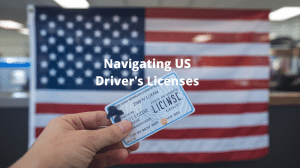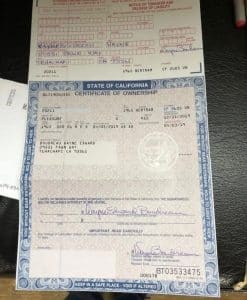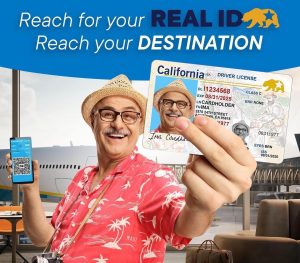
Ever driven behind the wheel of a 26,000-pound vehicle with a normal license? Asking yourself What is a Non Commercial Driver’s License? For most of us, that’s a hard no. But for 3.5 million commercial truck drivers in America, it’s just Tuesday.
The confusion between commercial and non-commercial driver’s licenses trips up more people than you’d think. One lets you drive the family sedan to Costco, the other lets you pilot vehicles that could flatten said Costco.
Understanding the differences between commercial and non-commercial driver’s licenses isn’t just bureaucratic trivia. It’s about knowing which doors (or highways) are open to you professionally, what responsibilities you’re taking on, and yes, what happens if you mess up.
So what exactly makes a CDL so different, and why might you need one even if you never plan to drive a semi?
ORDER A DRIVER’S LICENSE
What is a Non Commercial Driver’s License and a CDL?
Basic vs. Advanced: Two Different Worlds
When you’re cruising down the highway in your sedan, you might not think about the guy driving an 80,000-pound semi next to you needing totally different qualifications. But trust me, the gap between a regular driver’s license and a CDL is massive.
A standard driver’s license lets you drive personal vehicles like cars, SUVs, and small trucks. Pretty straightforward stuff. You take a basic knowledge test, maybe parallel park without hitting those orange cones, and you’re good to go.
A CDL? That’s a whole different ball game. Commercial drivers need to master complex vehicles, understand air brake systems, and handle hazardous materials safely. They’re basically operating rolling offices that weigh as much as 20 cars combined.
Key Differences That Matter
| Feature | Regular License | CDL |
|---|---|---|
| Vehicle Weight | Usually up to 26,000 lbs | Can exceed 26,000 lbs |
| Testing | Basic road rules, simple maneuvers | Extensive knowledge, pre-trip inspections, specialized skills |
| Medical Requirements | Minimal or none | Regular DOT physicals required |
| Restrictions | Few restrictions | Endorsements needed for specific cargo/vehicles |
| Penalties | Violations affect personal driving | Violations can end your career |
The penalties hit differently too. While getting a ticket in your car is annoying, CDL holders face stricter blood alcohol limits and harsher consequences that can destroy their livelihoods completely.
Bottom line: CDLs aren’t just upgraded licenses—they’re professional credentials that reflect specialized training for significantly higher responsibility.
What is the Difference Between a Commercial and Non-Commercial Vehicle?

What is the Difference Between a Commercial and Non-Commercial Vehicle?
The main difference boils down to purpose and weight. Commercial vehicles are primarily used for business activities like transporting goods or passengers for profit. Non-commercial vehicles are typically used for personal transportation.
Commercial vehicles generally:
-
Weigh 26,001 pounds or more
-
Transport 16+ passengers (including the driver)
-
Carry hazardous materials requiring placards
-
Are used to make money or conduct business operations
Non-commercial vehicles are what most of us drive daily – your standard cars, pickup trucks, and SUVs used for personal transportation, family trips, and daily commutes.
This distinction matters because commercial vehicles require operators to have Commercial Driver’s Licenses (CDLs), which involve more rigorous testing and stricter regulations due to the increased responsibility that comes with operating larger, heavier vehicles.
Hurt in an accident?
If you’re involved in an accident with a commercial vehicle, the situation becomes more complex than typical car accidents. Commercial vehicle accidents often result in more severe injuries due to the size and weight differences.
Here’s what makes these accidents different:
-
Multiple liable parties (driver, company, maintenance contractors)
-
Federal regulations may apply (FMCSA rules)
-
Different insurance requirements with higher coverage limits
-
More complex investigation processes
-
Potentially more serious injuries and damages
When injured in a commercial vehicle accident, it’s crucial to understand these distinctions as they directly impact your legal options and potential compensation.
What is the Difference Between Commercial and Non-Commercial Use?
The line between commercial and non-commercial driving isn’t just about what you do for a living—it’s about what you’re driving and why.
Commercial Use vs. Non-Commercial Use
Commercial use means you’re operating a vehicle to transport goods or passengers for profit or as part of a business. Non-commercial driving? That’s your everyday driving—taking kids to school, going grocery shopping, or heading to work in your personal vehicle.
Here’s a quick breakdown:
| Commercial Use | Non-Commercial Use |
|---|---|
| Transporting goods for business | Personal errands |
| Carrying paying passengers | Driving friends and family |
| Operating vehicles over 26,000 lbs | Driving personal vehicles |
| Hauling hazardous materials | Normal commuting |
| Towing commercial trailers | Recreational towing |
When Does Personal Driving Become Commercial?
You might be thinking, “I sometimes use my car for work tasks—does that count?” Good question.
The line gets blurry when you’re:
-
Using your personal vehicle to deliver packages for money
-
Driving for rideshare companies like Uber or Lyft
-
Transporting equipment for your small business
The defining factors typically include:
-
Whether you’re being paid specifically for the transportation
-
The size and type of vehicle you’re operating
-
How often you’re using the vehicle for business purposes
If you regularly drive commercially but only have a non-commercial license, you’re not just breaking rules—you’re putting yourself at serious risk for tickets, insurance problems, and even liability issues if an accident happens.
What is the Maximum Weight for a CDL Truck?

What is the Maximum Weight for a CDL Truck?
Weight limits for CDL trucks aren’t just random numbers – they’re carefully calculated to ensure road safety and prevent infrastructure damage. The federal maximum weight for a commercial truck is 80,000 pounds (40 tons) on interstate highways. This includes the combined weight of the truck, trailer, and cargo.
But here’s what many don’t realize – this limit can vary based on several factors:
-
State regulations: Some states allow higher weights with special permits
-
Axle distribution: Weight must be properly distributed across all axles
-
Bridge formula calculations: Determines safe weight based on axle spacing
Exceeding these limits isn’t just against regulations – it’s dangerous. Overloaded trucks require longer stopping distances, handle poorly, and put excessive strain on brakes and tires.
A. Injured in an accident?
Truck weight plays a crucial role in accident severity. When a fully loaded 80,000-pound truck collides with a 4,000-pound passenger vehicle, the physics are devastating.
If you’ve been injured in an accident involving a commercial truck, determining if weight violations occurred could significantly impact your case. Overloaded trucks may indicate negligence by:
-
The trucking company pushing unsafe loads
-
The driver failing to verify proper weight distribution
-
Loading dock personnel improperly securing cargo
After an accident, gathering evidence quickly is vital. Weight station records, driver logs, and shipping manifests can disappear fast. Working with an attorney experienced in commercial vehicle accidents ensures these critical pieces of evidence are preserved to protect your rights.
Types of Commercial Driver’s Licenses

Class A CDL
The heavyweight champ of commercial licenses, a Class A CDL lets you drive combination vehicles with a Gross Combined Weight Rating (GCWR) over 26,001 pounds, where the towed vehicle weighs more than 10,000 pounds. Think massive tractor-trailers and big rigs hauling heavy loads across state lines.
Truck drivers with this license can handle:
-
Semi-trailers
-
Truck and trailer combinations
-
Tanker vehicles
-
Livestock carriers
Getting a Class A opens the most doors job-wise, since you can operate almost any commercial vehicle except specialized ones requiring specific endorsements.
Class B CDL
This license covers single vehicles weighing over 26,001 pounds, or towing a vehicle under 10,000 pounds. Class B drivers typically handle:
-
Straight trucks
-
Large buses (school and city)
-
Segmented buses
-
Box trucks
-
Dump trucks with small trailers
If you’re driving something big but not connecting multiple heavy units together, the Class B is your ticket. Many municipal and delivery jobs require this license.
Class C CDL
Don’t underestimate the Class C. While it covers smaller commercial vehicles (under 26,001 pounds), it’s specifically for transporting either:
-
16+ passengers (including the driver)
-
Hazardous materials (HazMat)
Common Class C vehicles include:
-
Passenger vans
-
Small HazMat vehicles
-
Some smaller bus operations
Have you been involved in an accident?
If you’ve had a crash while driving a commercial vehicle, the stakes are higher than with regular licenses. CDL holders are held to stricter standards, with lower blood alcohol concentration limits and more severe penalties for violations.
After an accident, you must:
-
Report to your employer within 24 hours
-
Note any citations or violations, as these impact your CDL status
-
Understand that even off-duty violations in your personal vehicle can affect your commercial driving privileges
Your livelihood depends on maintaining a clean record, so consult with a specialized attorney if you’re facing violations that could threaten your CDL.
What are the Advantages of a CDL?
Expanded Career Opportunities
A CDL isn’t just a license—it’s your ticket to a whole new world of job opportunities. CDL holders can work as long-haul truck drivers, delivery drivers, bus drivers, or specialized equipment operators. The trucking industry alone is constantly hunting for qualified drivers, with companies offering sign-on bonuses and competitive wages to attract talent.
Higher Earning Potential
Let’s talk money. CDL holders typically earn significantly more than those with standard licenses. Entry-level commercial drivers often start at $40,000-$50,000 annually, while experienced drivers can pull in $65,000-$80,000 or more. Specialized endorsements like HAZMAT or tanker certifications can push your earning potential even higher.
Job Security and Stability
The transportation industry isn’t going anywhere. While technology evolves, we still need qualified professionals to move goods across the country. This translates to rock-solid job security for CDL holders. The American Trucking Association consistently reports a shortage of qualified drivers—meaning your skills will remain in demand.
Travel Opportunities
Tired of being stuck in an office? A CDL opens doors to see the country while getting paid. Many drivers appreciate the changing scenery and independence that comes with commercial driving jobs. You’re not just driving—you’re experiencing America from coast to coast.
Benefits Packages
Commercial driving positions typically come with comprehensive benefits packages that include health insurance, retirement plans, paid time off, and sometimes even tuition reimbursement programs. These benefits often exceed what’s available in other industries requiring similar education levels.
What is the Application Process for a Commercial Driver’s License?
Steps to Obtain a CDL
Getting a commercial driver’s license isn’t like picking up your regular driver’s license. The process is more rigorous—and for good reason. You’re handling big rigs that can weigh up to 80,000 pounds!
Here’s the breakdown of what you’ll need to do:
-
Meet the prerequisites – You must be at least 18 for intrastate driving (21 for interstate), have a valid regular driver’s license, and pass a DOT medical exam.
-
Get your CDL permit – Study your state’s CDL manual, then take written knowledge tests covering general knowledge, air brakes, and combination vehicles. This permit lets you practice driving with a licensed CDL holder.
-
Complete required training – Since February 2022, the FMCSA requires new CDL applicants to complete an Entry-Level Driver Training program from an approved provider.
-
Practice your skills – Spend time behind the wheel with an experienced driver before your skills test.
-
Pass the CDL skills test – This three-part exam includes:
-
Vehicle inspection
-
Basic control maneuvers
-
Road test
-
-
Pay the fees – CDL fees vary by state but typically range from $75-$200, plus additional costs for endorsements.
-
Receive your CDL – After passing all requirements, you’ll get your commercial driver’s license with any endorsements you’ve qualified for.
Remember, additional endorsements like Hazardous Materials require extra testing and possibly TSA background checks.
What are the Testing Requirements for a CDL?

Knowledge Tests: Not Your Average DMV Quiz
Think CDL knowledge tests are just like regular license tests? Think again.
CDL tests dig deeper into commercial driving rules and safety protocols. You’ll face questions about vehicle inspection, air brakes, combination vehicles, and hazardous materials if that’s your thing.
The general knowledge test? That’s mandatory for everyone. But depending on your vehicle and cargo plans, you’ll need specialized endorsement tests too.
Skills Test: Where the Rubber Meets the Road
This is where things get real. The skills test has three crucial parts:
-
Vehicle Inspection – You’ll demonstrate you know how to check your rig properly before hitting the road. Miss something important? Test over.
-
Basic Control – Can you maneuver that big vehicle precisely? You’ll show off skills like backing, parking, and docking.
-
Road Test – The finale! You’ll drive in actual traffic while an examiner watches your every move. They’re looking at how you handle the vehicle, follow traffic laws, and navigate challenges.
State Variations to Know
Each state has its own specific testing procedures and passing scores. Some states require appointment scheduling weeks in advance, while others accept walk-ins.
The passing score typically ranges from 80-85% on knowledge tests, with zero room for error on critical safety components of the skills test.
How Much Does a Commercial Driver’s License Cost?
CDL Costs Vary by State
Getting a CDL isn’t cheap – costs can range anywhere from $75 to over $3,000 depending on where you live and how you go about it. Each state sets its own fees, and they can differ dramatically.
In California, you’re looking at about $73 for the basic CDL application and tests. Meanwhile, New York charges around $164.50 for a Class A CDL that’s valid for 8 years.
Training Expenses
The real cost often comes from CDL training, not the license itself. If you’re going it alone, you’ll pay:
-
Application fee: $50-$100
-
Written test fee: $30-$60 per attempt
-
Skills test fee: $75-$200
But most folks need proper training. CDL programs typically run:
| Type of Training | Typical Cost Range |
|---|---|
| Private CDL School | $3,000-$7,000 |
| Community College Program | $1,000-$3,000 |
| Company-Sponsored Training | $0-$1,000 |
Hidden Costs to Consider
Don’t forget these additional expenses:
-
Medical examination fee ($50-$150)
-
Background check ($50-$100)
-
Endorsement fees ($5-$25 each)
-
License renewal fees ($50-$120)
Some employers offer to cover your training costs if you commit to working for them for a certain period – usually 1-2 years. This can save you thousands upfront, but make sure you understand the contract terms before signing.
How Do You Renew a CDL?

CDL Renewal Process
Renewing your CDL isn’t just a good idea – it’s mandatory if you want to keep earning a living behind the wheel. The process varies slightly by state, but the basics remain similar nationwide.
Most states allow you to renew your CDL every 4-8 years. Don’t wait until the last minute – start the renewal process at least a month before your license expires to avoid any gaps in your driving privileges.
Required Documents
When heading to your DMV for renewal, bring:
-
Your current CDL
-
Proof of identity (passport or birth certificate)
-
Proof of residency (utility bills or lease agreement)
-
Medical Examiner’s Certificate (if applicable)
-
Payment for renewal fees (typically $50-$120)
Medical Requirements
Most CDL holders need to provide an updated DOT medical card. Commercial drivers must pass a physical exam every 2 years, even if your license renewal cycle is longer. Some medical conditions might require yearly certification.
Testing Requirements
The good news? You typically don’t need to retake the skills test when renewing. However, depending on your state and how long it’s been since your last renewal, you might need to:
-
Take a vision test
-
Complete a written knowledge test
-
Verify your endorsements are still valid
Don’t forget – if you let your CDL expire beyond the grace period (usually 30-60 days), you might have to start from scratch with both written and skills tests. Mark those renewal dates on your calendar!
Contact a Truck Accident Lawyer Today
When Experience Matters Most
Truck accidents aren’t like fender benders. They’re devastating, life-changing events that leave families shattered and futures uncertain. If you’ve been hit by a commercial truck, you’re probably facing massive medical bills, lost wages, and pain that doesn’t seem to end.
This isn’t something you should handle alone. A specialized truck accident lawyer knows exactly how CDL regulations factor into your case. They understand how a commercial driver’s responsibilities differ from regular drivers, and how these differences can make or break your claim.
How a Truck Accident Attorney Helps
A good lawyer will:
-
Investigate whether the truck driver violated any CDL requirements
-
Determine if hours-of-service regulations were ignored
-
Access and analyze the truck’s black box data
-
Identify if proper maintenance protocols were followed
-
Establish if the trucking company cut corners on safety training
Don’t Wait to Get Help
The trucking company already has their legal team working against you. Their insurance adjusters started building their defense the moment the crash happened.
Time is critical. Evidence disappears, memories fade, and there are strict deadlines for filing claims. The sooner you contact a truck accident lawyer, the better your chances of receiving the compensation you deserve.
Your recovery should be your priority—let a lawyer handle the complex legal battle while you focus on healing.
Tell Us About Your Case.
Share Your License Dilemma With Us
Got a commercial driving issue? We’ve been there. Whether you’re wrestling with a CDL suspension, facing traffic violations that could jeopardize your livelihood, or simply confused about the differences between commercial and non-commercial licenses – we get it.
Truck drivers, bus operators, and delivery professionals – your license isn’t just a card, it’s your career. When something threatens that, you need someone who understands both the road and the law.
Our team has helped countless drivers navigate the complex regulations surrounding CDLs. From medical certification issues to out-of-state violations, we’ve seen it all and know how to help.
The consultation is straightforward:
-
Tell us what happened
-
Share any paperwork you’ve received
-
Explain your concerns and goals
-
Ask us anything – no question is too small
Your story matters to us. The specifics of your situation – where the incident occurred, what vehicle you were operating, your driving history – all play crucial roles in determining the best path forward.
Don’t let license issues derail your career. The sooner you reach out, the more options we’ll have to protect your commercial driving privileges. Your livelihood is worth fighting for, and we’re ready to stand beside you.
OFFICE LOCATIONS

A. Bakersfield
Our Bakersfield office helps CDL applicants navigate the complex requirements for commercial licenses. Located conveniently off Highway 99, we’ve assisted countless truck drivers, bus operators, and delivery professionals in understanding the stark differences between commercial and standard licenses.
B. Beverly Hills
The Beverly Hills location specializes in helping entertainment industry professionals who need CDLs for production vehicles and equipment transport. Our team here understands the unique needs of film and TV transportation coordinators.
C. Los Angeles
Our busiest office sits in downtown LA, where we serve a diverse clientele of commercial drivers. This location offers extended hours specifically for truckers and delivery professionals working non-traditional schedules.
D. Palmdale
Palmdale serves the Antelope Valley’s growing logistics industry with specialized CDL assistance. Many of our clients here operate heavy machinery and construction equipment requiring commercial licensing.
E. Santa Ana
The Santa Ana office provides bilingual services for Orange County’s commercial driving community. We’ve built strong relationships with local trucking companies and regularly host CDL preparation workshops.
F. Sacramento
Being near the state capital, our Sacramento office stays current with all commercial driving legislation and regulatory changes. We’re the go-to resource for government fleet drivers and private sector commercial operators alike.
G. San Francisco
Our San Francisco location addresses unique urban driving challenges faced by commercial operators in dense city environments. We offer specialized guidance for navigating weight restrictions on city streets and bridges.
H. Fresno
Serving the agricultural heart of California, our Fresno office specializes in helping farm equipment operators and agricultural transport drivers obtain proper commercial licensing.

Commercial and non-commercial driver’s licenses serve different purposes, with CDLs specifically designed for operating larger, more complex vehicles for business purposes. Understanding the distinctions between these licenses—from vehicle classifications and weight restrictions to application processes and renewal requirements—is essential for anyone considering a career in commercial driving or operating vehicles that exceed standard weight limits.
Whether you’re pursuing a CDL for professional advancement or simply exploring your options, it’s important to weigh the advantages against the costs and requirements. If you’ve been involved in a truck accident or have questions about commercial driving regulations, don’t hesitate to contact a qualified truck accident lawyer who can provide guidance tailored to your specific situation. Your path to safe, legal commercial driving begins with being properly informed and licensed.
ORDER NOW






